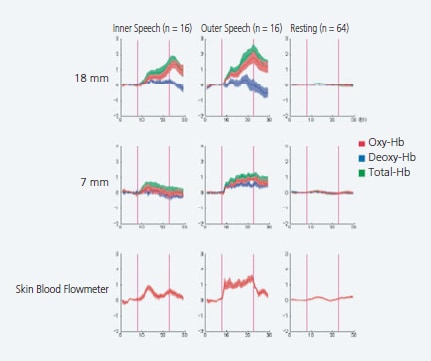Investigating Inner Speech
NIRS signals from the head surface were used to estimate the time when the subject made inner speech without vocalization and to guess a number between 1 and 5 reechoes by the subject in his/her mind.
Two separations between transmitter and receiver optical fiber probes (7 and 18 mm spacing), as shown in Fig. 1, were used to measure the NIRS signals across the entire left and right forehead. Simultaneous measurements of the scalp blood flow and electromyograms were performed to evaluate the effects of skin blood flow and muscle blood flow on NIRS signals.

Fig. 1 Multiresolution Analysis
The probe channel positions are projected onto the MRI brain surface image. Probes are placed at 18 mm spacing in a 3×5 arrangement over the entire left and right forehead (44 ch), and at 7 mm spacing on the left forehead (1 ch).
Fig. 2 shows typical NIRS signals when the subject recites a tongue twister internally without vocalization when the chosen number is read. Multiple channels containing Broca's area (representative channel 11) show a transient increase in Oxy-Hb and Total-Hb concentrations when the chosen number 3 is read.

Fig. 2 Typical NIRS Waveforms Blood Flow Fluctuations in Broca's Area (representative channel 11).
NIRS waveform results from four subjects were visually evaluated by five researchers. They were able to determine the number chosen by the subject with 73 % accuracy.

Fig.3 NIRS Waveforms, Skin Blood Flow Fluctuations, Electromyogram during Inner Speech and Outer Speech
The large changes in the electromyograms of the left and right platysma and temporal muscles that occur under outer speech conditions when a tongue twister is recited out loud indicate activity in these muscles. Increased skin blood flow measured by the Doppler skin blood flowmeter can be observed throughout the outer speech period. NIRS measurements at the short probe spacing (7 mm) also indicate that Oxy-Hb and Total-Hb concentrations increase continuously during the outer speech period (Fig.3). Conversely, no changes in the platysma and temporal electromyograms are apparent with inner speech. This provides objective evidence that no vocalization occurs. The short transient increases (interval approx. 5 sec, rising latency tune approx. 3 sec) were detected by the Doppler skin blood flowmeter, although not as large as for outer speech and no continuous increase in blood flow was apparent (Fig. 3).

Fig.NIRS and Skin Blood Flow Average Waveforms during Inner Speech, Outer Speech, and Resting
Shadow width ±1S.E. Resting shows the average waveform when a number different from the pre-chosen number is read.
The NIRS signals in the representative channel near Broca's area and the averaged Doppler skin blood flow signals yielded similar results (Fig. 4). These results indicate that it is necessary to consider at least the skin blood flow and muscle activity effects when interpreting the NIRS signals during NIRS measurement tasks involving vocalization. The possibility remains that even during inner speech involving no vocalization, skin blood flow fluctuations due to autonomous nervous system activity may affect the NIRS signals. Consequently, a method to eliminate the effects of skin blood flow and muscle activity on NIRS signals is particularly important when performing measurements to measure brain functions.
NIRS measurements make it possible to estimate the time when the subject recited a tongue twister internally without vocalization and further estimate the number pre-chosen by the subject with a certain degree of accuracy. It was confirmed that the NIRS measurements with 7 mm probe spacing produced data reflecting the skin blood flow fluctuations and that the NIRS measurements with 18 mm probe spacing produced data reflecting brain blood flow fluctuations independent of the skin blood flow fluctuations. The ability to distinguish between brain activity-derived NIRS signals and skin blood flow signals during inner speech promises future applications of NIRS measurements to BMI.
(Data supplied by: Shigeru Kitazawa, MD, PhD, Juntendo University School of Medicine
Reference: Iwano, T., Takahashi, T., Takigawa, J., Kawagoe, R., Shibuya, S., Kitazawa, S. (2010) "Detection of inner speech using near infrared spectroscopy", Shimadzu Review, Vol. 66, No. 3, 4
Note: The data shown was acquired using a FOIRE/OMM series model.
Related Products

LABNIRS
functional Near-Infrared Spectroscopy System for Research
The laboratory model is ideal for a wide variety of basic research fields.
With a broad range of possible measurement regions, it can be readily customized for specific experimental conditions.

LIGHTNIRS
Portable functional Near-Infrared Spectroscopy System for Research
The portable model is ideal for field research.
It expands the possibilities for measuring brain function in a diverse range of applications and research fields.




